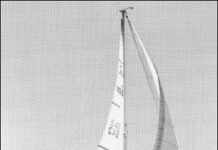Jeanneau Arcadia
Like most of the Jeanneaus, the Arcadia (pronounced "Are-caw-dee-yah") is rare in America--only a few were imported--but, also like most of the Jeanneaus, the total production run is incredible--the factory popped out 600 completed boats in the Arcadia's first two years. The only American company that could even aspire to such numbers in a 30-footer is Catalina, and they produce a miniscule number of models compared to Jeanneau.
Lancer 28
The Lancer 28, built from 1977 to 1985, seems a rather tame and ordinary boat. Part of the variety in the Lancer line stems from the use of a number of different designers. Turner designed both the 25 and 28, the smallest Lancers from 1977 to 1983. Both are shoal-draft fixed-keel trailerables. The 25 and 28 are attractive boats with short ends, flattish sheer, and Swan-type bubble deckhouses.
Newport 28/28 II
There is a strong family resemblance between the Newport 28 and other C&C designs of the same period. In addition to the Newport 28, Capital built the Newport 41, another mid-1970s C&C design. The styling of both boats is characterized by the sweeping attractive sheerlines for which C&C is justifiably known.
O’Day 22
O'Day Boats was around a long time by fiber-glass boatbuilding standards--about 30 years. When it was introduced, the O'Day 22 was touted as a competitive contender on the race course, a contrasting companion to the rather hazy 23-footer which it would soon phase out. The 22 had a masthead rig, a stylish rake to the transom, shallow (23") draft with a short stub keel and no centerboard, and a light weight (advertised 1,800 lbs) for trailering. Later, the 22 acquired a fractional rig, a centerboard and 300 advertised pounds.
Olson 30
The Olson 30 is of a breed of sailboats born in Santa Cruz, California called the ULDB, an acronym for ultra light displacement boat. ULDBs are big dinghies--long on the waterline, short on the interior, narrow on the beam, and very light on both the displacement and the price tag. ULDBs attract a different kind of sailor--the type for whom performance means everything.
S2 7.9
Originally known for cruising designs, S2 Yachts opened their second decade in business by entering the high performance field, building first a trailerable racer/cruiser, the S2 7.9. The 7.9 stands for meters, which translates into American as 25' 11". The boat stayed in production up until S2 shut down its sailboat operations in 1986.
S2 8.5 Meter
In the early '80s, S2 8.5 Meter reached more for the performance market with the Grand Slam series of small boats, and the 10.3 "offshore racer-cruiser." These higher performance boats were designed by Scott Graham and Eric Schlageter, well known for their MORC and smaller IOR designs. The S2 8.5 is a 28-footer cast in the company's traditional mold. Her hull dimensions, sail area, displacement, and general design characteristics put her square in the middle of the modern 28-footers such as the Tanzer 8.5, Newport 28, O'Day 28, and the Pearson 28.
Sabre 28
Owners report that the primary motivation for purchasing the Sabre 28 can be summed up in one word: quality. Sabre is quite conscious of their image as producing a high-quality boat. The boat attracts buyers willing to pay a little more than average for a boat that is better than average. The Sabre 28 is conventionally modern in appearance. She has a modest concave sheer, straight raked stern, and short after overhang. With optional wheel steering, optional cockpit-led halyards, and optional self-tailing headsail sheet winches, the Sabre 28 can easily be handled by one or two people. The mainsheet is within easy reach of the helmsman. Unfortunately, his head is also within easy reach of the mainsheet when jibing, except on newer boats; the mainsheet was relocated to the cabin top in 1982.
Sea Sprite
The Sea Sprite 23 is a trim but rugged daysailer-overnighter from naval architect Carl A. Alberg that enjoyed a 25-year production run under several different Rhode Island builders, most notably Clarke Ryder. It's a typical Alberg design--narrow beam, full keel and conservative ballast-to-displacement ratio and graceful lines. This is a boat that still turns heads when it sails into a harbor.
Stiletto
It's hard to mistake the Stiletto's appearance, with blazing topside graphics and aircraft-style, pop-top companionway hatches. It's also hard for the average sailor to appreciate the sophistication of the Stiletto's construction--epoxy-saturated fiberglass over a Nomex honeycomb core.











































